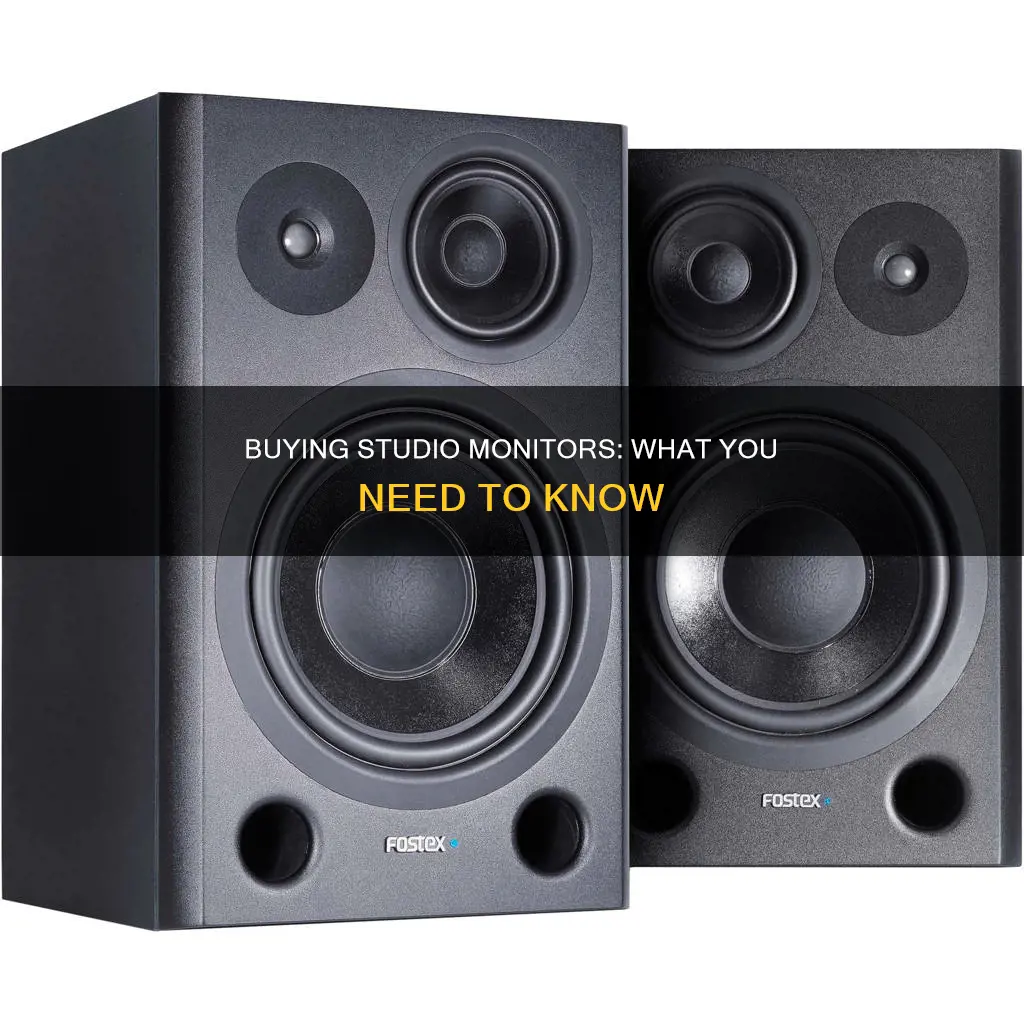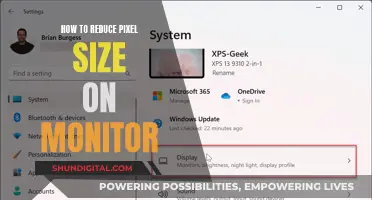
Studio monitors are a key tool for achieving the best sound from your mix. They are highly accurate speakers designed to reveal details that may be missed when using headphones or regular speakers. When choosing which studio monitors to buy, there are several factors to consider, including your intended use, budget, and the equipment you already have.
Studio monitors are commonly defined as either active or passive. Active monitors have a built-in power amplifier, while passive monitors require a separate amplifier. Active monitors tend to be heavier and more expensive, but they offer higher accuracy and protection against amplifier and speaker damage. Passive monitors, on the other hand, offer more flexibility in customising components and are usually cheaper.
When it comes to speaker size, larger monitors generally provide a wider dynamic range and a further listening distance, but they may not be necessary or suitable for smaller rooms. The size of the woofer will affect the volume of the monitor, with larger woofers producing louder sounds. However, smaller monitors can often provide a flatter frequency response, while bigger speakers may be unfairly weighted towards the bottom end.
In addition to size and type, other important features to consider when choosing studio monitors include frequency range, sound pressure level, sensitivity, and impedance. It's also crucial to ensure that the monitors have the right connections to work with your existing equipment.
Some popular options for studio monitors include the Yamaha HS5/HS8, KRK Rokit 5 G4/G5, Mackie CR4, Adam Audio A7V, and Genelec 8000 Series. These monitors offer a range of features and price points to suit different needs and budgets.
What You'll Learn

Active vs. Passive Monitors
When it comes to studio monitors, you have two options: active or passive. So, which one should you choose? Let's take a closer look at the differences between the two and the advantages of each system to help you decide.
Active Monitors
Active studio monitors have built-in amplifiers, which means they are simpler to set up and use as you don't need any additional equipment. The built-in amplifiers are specifically designed for the monitors, which can result in better overall sound quality. Active monitors are often more convenient, especially for those who want a plug-and-play solution. Additionally, they usually offer more control over frequency response and more precise sound reproduction, making them a common choice for professional studios.
Passive Monitors
Passive monitors, on the other hand, require external amplifiers to function. This setup offers more flexibility as you can choose and upgrade your amplifier separately from the monitors. Passive monitors are typically more cost-effective and allow for a more gradual progression to higher-quality gear. They are also preferred by some audio professionals due to their ability to match the amplifier to the speakers optimally.
Both active and passive monitors have their advantages, and the choice depends on your specific needs and preferences. If you want a simple, convenient solution with built-in amplifiers, active monitors are the way to go. On the other hand, if you prioritise flexibility and are willing to put in the effort to set up an external amplifier, passive monitors might be a better choice. Ultimately, the decision should be based on your budget, the complexity of the setup, and your personal preferences.
Monitoring Bandwidth Usage: Track IP Address Activity
You may want to see also

Power – How Many Watts Do I Need?
When it comes to studio monitors, the power handling of the system will have a significant impact on the overall sound, affecting not just the volume but also your dynamic range and the amount of headroom you have before signals peak. Higher wattage means you'll be able to hear more transient detail and make more precise adjustments to compressors, limiters, and gates.
For example, if you're listening to a mix on two monitoring systems with the same average volume level but different wattages, the system with higher wattage will give you more headroom. This is because music peaks, such as snare hits or kick drums, can demand up to ten times more power than average program material. So, if your mix demands an average of 20 watts, the peaks could require up to 200 watts. In this case, an amplifier that can deliver a clean 70 watts would still be 130 watts short, resulting in greater distortion and possibly clipping during the musical peak.
While more wattage will indeed produce more volume, it will also provide more definition and dynamic range. Therefore, it's important to consider the power requirements when choosing studio monitors to ensure optimal sound quality and performance.
Transforming CNC CRT Monitors to LCD Displays
You may want to see also

Different Driver Types and Why They Matter
Studio monitors are loudspeakers designed for professional audio production applications. They are used in recording studios, filmmaking, television studios, radio studios, and project or home studios. Studio monitors are designed to produce a relatively flat (linear) phase and frequency response, meaning there is minimal emphasis or de-emphasis of particular frequencies.
Studio monitors usually consist of two separate drivers or speakers: a tweeter and a woofer. The tweeter is the smaller, higher driver and is often cone- or dome-shaped. It is responsible for producing high frequencies, usually starting at around 2 kHz. The woofer is generally cone-shaped and placed below the tweeter. It produces low and mid-range frequencies.
Some studio monitors feature a third driver, known as a mid-range speaker, which produces mid-range frequencies. This type of monitor is called a three-way system.
The different types of drivers and the way they are configured can have a significant impact on the sound quality and performance of studio monitors. Here are some of the most common driver types and how they affect the sound:
- Two-Way Drivers: This is the most common type of driver configuration, with one tweeter and one woofer. The tweeter handles high frequencies, while the woofer handles low and mid-range frequencies. This configuration offers a simple and cost-effective solution for studio monitors.
- Three-Way Drivers: Three-way drivers feature a dedicated mid-range driver in addition to the tweeter and woofer. This configuration provides more accurate sound reproduction, as each driver is optimised for a specific frequency range. This results in improved sound clarity and definition, making it easier to identify and fix issues in the mix.
- Four-Way Drivers: Four-way drivers are less common and typically consist of a standard three-way setup with an additional subwoofer. This configuration is often used in larger studio setups where more powerful and extended bass response is required.
- Single-Driver: Single-driver studio monitors, such as the Auratone 5C, have only one driver responsible for reproducing the full frequency range. These monitors are often used as secondary references to check how mixes will sound on typical consumer speakers. They are valued for their ability to provide a focused perspective on the midrange frequencies, which are crucial in pop productions.
The choice between these different driver types depends on various factors, including the intended use, budget, and specific requirements of the studio setup. Two-way drivers are generally more affordable and suitable for most basic studio monitoring tasks. Three-way and four-way drivers offer more accurate and detailed sound reproduction but come at a higher cost. Single-driver monitors are specialised tools often used in conjunction with full-range monitors to provide a different perspective on the mix.
In summary, the different driver types in studio monitors play a crucial role in shaping the sound and performance of the speakers. The choice between them depends on the specific needs and constraints of the user, with each type offering unique advantages and considerations.
Transforming Old LCD Panels into Functional Monitors
You may want to see also

Cabinet Considerations: Ported or Closed?
When it comes to studio monitors, there are two types of cabinets to choose from: ported and closed. But what's the difference, and which one is right for you?
Ported cabinets feature a hole cut into the cabinet, along with a section of tubing, to allow sound from the rear of the speaker's diaphragm (cone) to enhance the reproduction of low-end frequencies. This type of cabinet is typically used in smaller studio monitors to extend the frequency response lower for more bass. While this can be beneficial, the sonic accuracy of ported cabinets may not be as precise as closed cabinets. This is especially true if the ports are on the back of the speakers and they are placed too close to a wall. If you can't avoid putting your studio monitors near walls or corners, you may want to choose front-ported or closed designs for more accurate monitoring.
On the other hand, closed or sealed cabinets don't have any ports, resulting in more accurate and precise sound reproduction. This type of cabinet is often found in larger studio monitors, where the larger speaker size helps to compensate for the lack of porting.
So, which one should you choose? If you're working in a small room or need more bass response, ported cabinets might be a better option. If you prioritise accuracy and precision, closed cabinets are the way to go. Keep in mind that the size of your room and the placement of your monitors will also play a role in your decision. If you have to place your monitors near walls or corners, front-ported or closed cabinets are usually the better choice.
Hooking Up a TFT Monitor: A Step-by-Step Guide
You may want to see also

Placement and Isolation
The placement of your studio monitors is crucial to achieving the optimal sound experience. The ideal setup is to form an equilateral triangle with your head when seated in your mix position, with the monitors placed at the same distance from each other as they are from you. This setup will result in the most accurate frequency response and the clearest stereo image.
If you're working with a multichannel surround sound system, the placement becomes more complicated, and you may need to consult an expert for guidance.
To improve the sound of your monitors, consider using speaker stands instead of placing them directly on a desk or mixing console. Sound reflection from the desk or console can cause subtle comb filtering, reducing the accuracy of your monitoring.
Additionally, you can use a small mirror to identify any hard surfaces surrounding or between you and the monitors that may reflect sound. If you can see the monitor's reflection in the mirror from your mix position, treat that surface with sound-absorbing material.
Speakers will also transmit energy into the surface they are placed on, causing sonic distortions. To address this, place your studio monitors on stands with isolation pads, which will provide the best isolation.
The size of your room will also impact the placement of your monitors. If you have a small room, larger monitors may be unnecessary and even create issues with bass response. Conversely, if you have a large room, you may need larger monitors to achieve sufficient volume levels and a wider "sweet spot".
Remember that the goal of studio monitors is to provide an accurate and precise representation of your music, revealing all the details in your mix. Proper placement and isolation are crucial steps in achieving this goal.
LCD Monitor Functionality: Understanding the Inner Workings
You may want to see also
Frequently asked questions
Studio monitors are highly accurate speakers designed to reveal the best and worst parts of your sound. Unlike regular speakers, they have a flat frequency response, meaning they don't emphasise any particular frequency range. Studio monitors are either active or passive. Active monitors have a built-in amplifier, while passive monitors require a separate amplifier.
You should consider the size of your room, the type of music you're producing, your budget, and the equipment you already have. The size of your room will determine the size of the monitors you need – larger rooms will require larger monitors. If you're producing bass-heavy music, you'll need monitors with good bass response or a subwoofer. Your budget will dictate the quality of the monitors you can buy, but you can get good results for under $500. Finally, check that the monitors are compatible with your existing equipment, paying attention to the type of connections available.
Active monitors are more convenient as they don't require a separate amplifier. They also ensure better sonic performance as the internal amplifier is specifically matched to the speaker. Passive monitors offer more flexibility as you can customise the components, but they may be more challenging to set up optimally.
Near-field monitors are designed for smaller studios and closer listening distances. They help minimise the effect of room acoustics on the sound. Mid-field monitors are for larger studios and longer listening distances. They provide a wider "sweet spot" and a bigger sound but are more likely to excite room modes (acoustical cancellations and reinforcement at various bass frequencies).
Place your monitors so that they form an equilateral triangle with your head when seated in your mixing position. This will result in the most accurate frequency response and clearest stereo image. If you can't avoid placing your monitors close to walls or corners, choose front-ported or closed cabinet designs to minimise bass boost. Consider using speaker stands and isolation pads to improve sound quality and reduce vibrations.







